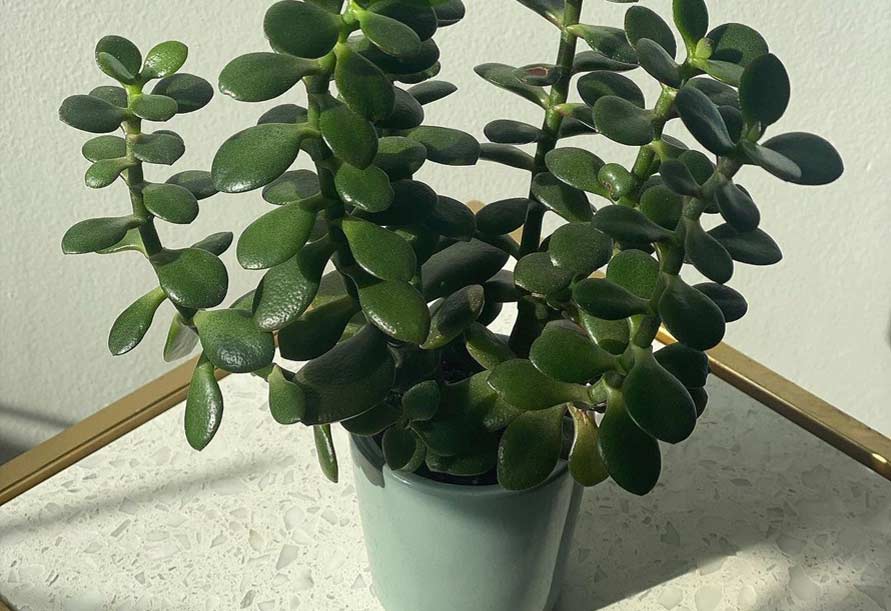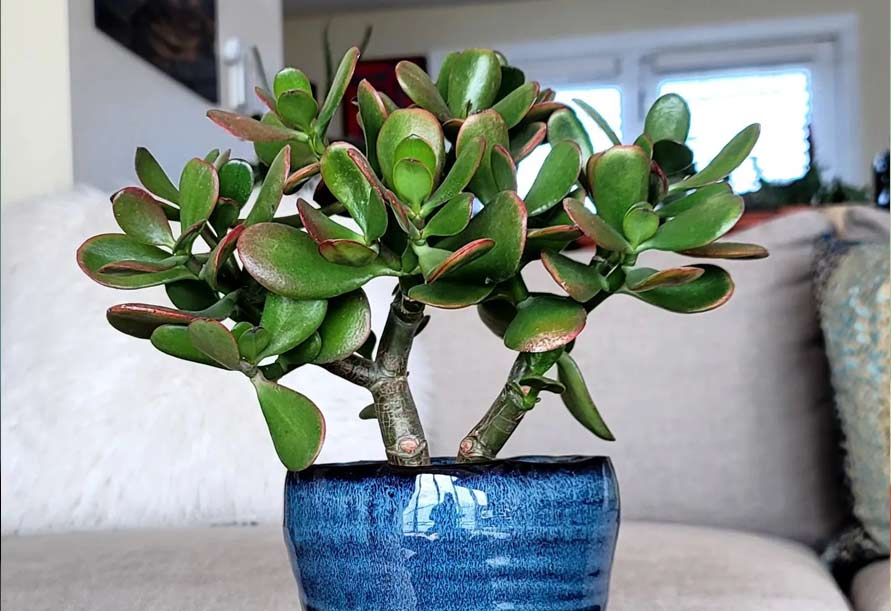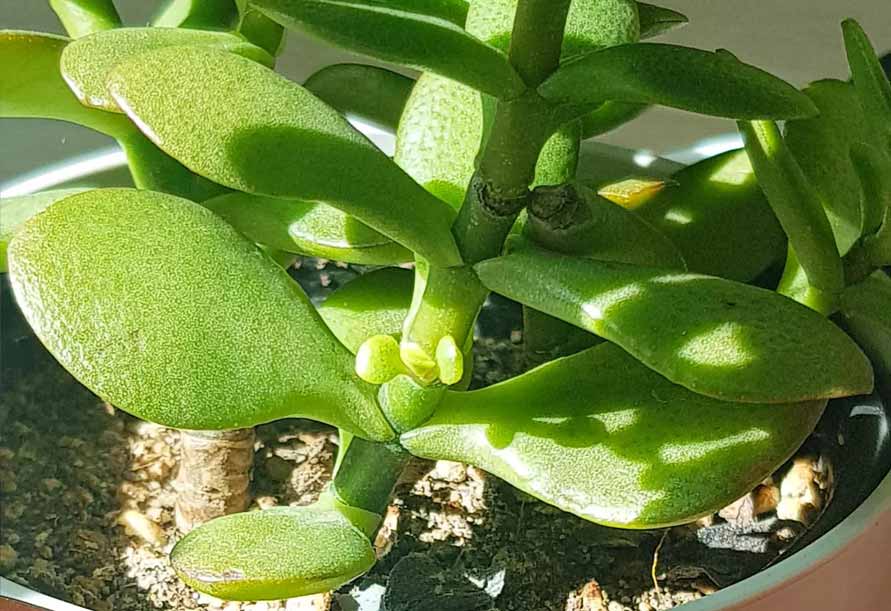Blog
Jade Plant
Jade Plant

You may have seen miniature shrubs of this plant in florists. Crassula Ovata or Jade Plant is one of the most popular houseplants that grow well in the apartment. This plant belongs to the southern regions of Africa, and it is interesting to know that there are now more than 350 species like it all over the world. In this article, we want to make you more familiar with the storage conditions of Jade Plant or Crassula Ovata. Please read on with Alo Plant.
| Jan | Feb | Mar | Apr | May | Jun | Jul | Aug | Sep | Oct | Nov | Dec | |
|---|---|---|---|---|---|---|---|---|---|---|---|---|
| Sowing | ||||||||||||
| Planting | ||||||||||||
| Harvesting |
| J | F | M | A | M | J | J | A | S | O | N | D | |
|---|---|---|---|---|---|---|---|---|---|---|---|---|
| Sowing | ||||||||||||
| Planting | ||||||||||||
| Harvesting |
| Botanical Name | Crassula ovata |
| Common Name | jade plants |
| Plant Type | Succulent |
| Pet / Baby Safe | Toxic to humans and pets |
| Sun Exposure | Full sun |
| Hardiness Zones | 10 and 11 |
| Bloom Time | Spring (rarely blooms indoors) |
| Soil Type | Well-drained |
| Soil Amendments | text here |
| Types of Fertilizer | text here |
| Flower Color | White |
| Foliag Color | Blue, green |
| Plant Height | 36–72 in. tall, 24–36 in. wide |
| Native Area | South Africa |
Introduction to Jade Plant or Crassula Ovata

With the scientific name of Crassula Ovata, Jade Plant is one of the valuable ornamental plants, which is known as a popular species of miniature plants due to its beautiful appearance. The height of this plant sometimes reaches up to 1.8 meters, but in general, it has relatively slow growth. Crassula is a variety of succulent plants that, in addition to being beautiful, make the home atmosphere pleasant and energetic. This hardy and beautiful plant can be easily turned into a bonsai by pruning.
The temperature required for Jade Plant or Crassula Ovata to grow
Jade Plant is one of the native plants of the tropics, and the most suitable temperature for its cultivation and maintenance is 21 to 34 degrees Celsius. Note that this plant should not be placed in the cold under any circumstances. Because most Crassula species do not tolerate cold and are severely damaged at temperatures below 5 ° C.
How to irrigate Jade Plant at home

A significant factor in growing and maintaining a Jade Plant is knowing how much irrigation they have throughout the year. It would help if you understood that Jade Plant does not need much irrigation and has good resistance to water shortage. The best time to irrigate this plant is when between 3 to 4 cm of irrigation has dried on the pot’s soil. When watering the Jade Plant, it is recommended to ensure the bottom of the pot and its drainage, and preferably use boiled water or distilled water for this purpose.
Pruning Jade Plant or Crassula Ovata
In general, Jade Plant does not require special pruning. Still, to maintain the plant’s appearance and make it more beautiful, you can prune the damaged foliage as desired and make it denser by pruning several branches. Be careful not to prune more than 30% of its foliage, as excessive pruning can cause shock to the plant and destroy it. The best time to prune this plant is late winter to early spring.
Light suitable for storing Jade Plant or Crassula Ovata

This plant needs a few hours of gentle sunlight to grow properly. If Crassula grows in indirect sunlight, it may grow slowly or grow grassy, making it look unattractive. So try to provide a few hours of daylight in the storage area for the plant to grow better so that the sun’s rays do not burn the leaves. This plant likes light from morning to noon more than afternoon light because the presence of higher temperatures than the morning with direct sunlight can increase the damage to the plant.
Jade Plant or Crassula Ovata pot replacement conditions
Different species of Jade Plant can take root in small pots. Planting them in small pots makes the plant smaller and more controllable. So try to change the young plant pot every 2 to 3 years in early spring to grow more. Of course, this also applies to mature plants up to 4 to 5 years old. It is also best not to water the plant for a week or more after changing the pot.
Jade Plant propagation methods at home
There are two ways to propagate and multiply a Jade Plant, which we will consider here:
Method of propagation through leaves

To propagate Jade Plant through leaves, the leaves of this plant can be separated from the bushes and young shoots and planted in a suitable substrate. This bed can be a combination of sand and perlite. It should be noted that the formation of roots may take up to a month, and it is better not to neglect the proper irrigation of the desired rootstock during this period.
Propagation method through the stem

To increase the Jade Plant through the stem, you must first gently remove the pest-free stem 4 to 6 cm long from this plant. Then, after cutting the stem, place it in a semi-sunny environment for one to two days and plant the cuttings in a small pot with soil for cuttings. It is better to place the pot in an environment with adequate light and temperature.
The best method of fertilizing pots is Jade Plant or Crassula Ovata
For better growth of the Jade Plant, it is recommended to fertilize it in spring and summer. For this purpose, you can use fertilizers for cactus and succulents or fertilizers for houseplants once every two weeks.
The most common pests are Jade Plant or Crassula Ovata.

The most common pest for Jade Plant or Crassula Ovata species is the flour beetle, which is located between the stem and leaves of the plant. This pest feeds on plant sap and leaves a sticky discharge. To solve the problem of flour beetle contamination and plant care, clean the plant frequently with alcohol to eliminate these insects. In severe cases, you must destroy the plant.
Why is the Jade Plant shrinking?
When the Jade Plant does not receive enough light, it scatters and shrinks its branches and leaves. This is a defensive reaction and is done for two reasons. The first is that the plant can manage the little energy it receives, and the second is that low light causes the knot between the leaves to be stretched too much to push the plant higher and towards the light, as a result of which the plant becomes short and bare.
Conclusion
With its beautiful and miniature appearance, Jade Plant is always one of the attractive options for use in homes and apartments. This species is mainly native to southern Africa and poisonous for pets and infants. Jade Plant has been used as a houseplant in many countries. You can breed and propagate them by knowing their maintenance systems, such as suitable ambient temperature, soil conditions, and suitable distances for irrigation. In this article, we will give you a reasonably comprehensive overview of maintaining a Jade Plant. If you have any questions or concerns about this issue, please contact us in the comments section.
RELATED POSTS













